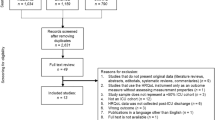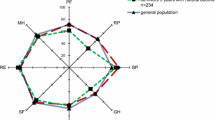Abstract
Evaluations of intensive care have largely focused on survival, cost, or functional status; however, these may not be the only outcomes of interest to patients, families, and health care providers. Quality of life is an important consideration in evaluating intensive care because it influences decisions about the use of life-sustaining treatment. A study was conducted to assess the quality of life of survivors of intensive care to determine the relationship of perceived quality of life to other outcomes of intensive care. Patients at least 55 years old who received medical intensive care during 1983 (n=69) were interviewed to determine social characteristics, functional status, psychological well-being, and their perceived quality of life using a new 11-item Perceived Quality of Life scale. Functional status correlated only moderately with perceived quality of life (r=0.49, p=0.0001). Objective measures of patients’ material and social resources did not predict satisfaction. To evaluate outcome adequately, it is necessary to assess perceptions of life quality from patients who have received life-sustaining treatment.
Similar content being viewed by others
References
Berenson RA. Intensive care units (ICUs): clinical outcomes, costs, and decision making. Washington, DC: Office of Technology Assessment, US Congress OTA-HCS-28, 1984
Parno JR, Teres D, Lemeshaw S, Brown RB, Avrunin JS. Two-year outcome of adult intensive care patients. Med Care 1984;22:167–76
Goldstein RL, Campion EW, Thibault GE, Mulley AG, Skinner E. Functional outcomes following medical intensive care. Crit Care Med 1986;14:783–8
Chassin MR. Costs and outcomes of medical intensive care. Med Care 1982;20:165–79
Knaus WA, Draper EA, Wagner DP, et al. Evaluating outcome from intensive care: a preliminary multihospital comparison. Crit Care Med 1982;10:491–6
Cullen DJ, Keene R, Waternaux C, et al. Results, charges, and benefits of intensive care for critically ill patients: update 1983. Crit Care Med 1984;12:102–6
President’s Commission for the Study of Ethical Problems in Medicine and Biomedical and Behavioral Research. Deciding to forego life-sustaining treatment. A report on the ethical, medical, and legal issues in treatment decisions. Washington, DC: US Government Printing Office, 1983
Patrick DL, Elinson J. Sociomedical approaches to disease and treatment outcomes. Qual Life Cardiovasc Care 1984;1:53–62
Hornquist JO. The concept of quality of life. Scand J Soc Med 1982;10:57–61
Danis M, Green M, Southerland LI, Patrick DL. Patient and family preferences for medical intensive care. Clin Res (abstr) 1987;35:737
Donald CA, Ware JE Jr. Quantification of social contacts and resources. Santa Monica CA: Rand Corporation, 1982 (Rand Publication No. R-2937-HHS)
Bergner M, Bobbitt RA, Carter WB, Gilson BS. The Sickness Impact Profile: development and final revision of a health status measure. Med Care 1981;19:787–805
Dupuy H. The Psychological General Well-being (PGWB) Index. in: Wenger NK, Mattson ME, Furberg CD, Elinson J (eds). Assessment of quality of life in clinical trials of cardiovascular therapies. New York: LeJacq, 1984
Knaus WA, Draper EA, Wagner DP, Zimmerman JE. APACHE II: a severity of disease classification system. Crit Care Med 1985;13:818–29
Nunnally JC. Psychometric theory. New York: McGraw-Hill, 1978
Campion EW, Mulley AG, Goldstein RL, Barnett GO, Thibault GE. Medical intensive care for the elderly. A study of current use, costs, and outcomes. JAMA 1981;246:2052–6
Deyo RA, Inui TS, Leininger J, Overman S. Physical and psychosocial function in rheumatoid arthritis. Clinical use of a self-administered health status instrument. Arch Intern Med 1982;142:879–82
National Center for Health Statistics. Health, United States, 1984. Washington, DC: DHHS Pub. No. (PHS) 85-1232, Public Health Service, US Government Printing Office, 1984
Norburn J, Patrick DL, Beresford SA, Stein J. Functional status and perceived quality of life among older persons. Proceedings of the 21st Public Health Conference on Records and Statistics, 13–15 July 1987. Washington, DC: National Center for Health Statistics, 1987
Zaren B, Hedstrand U. Quality of life among long-term survivors of intensive care. Crit Care Med 1987;15:743–7
Festinger L. A theory of cognitive dissonance. New York: Row Peterson, 1957
Brickman P, Campbell DT. Hedonic relativism and planning the good society. In: MH Appley (ed). Adaptation-level theory: a symposium. New York: Academic Press, 1971
Croog SH, Levine S. Life after a heart attack. New York: Human Sciences Press, 1982
Andrews FM. Research on the quality of life. Ann Arbor, MI: University of Michigan, 1986
Mcdowell I, Newell C. Measuring health. New York: Oxford University Press, 1987
Najman J, Levine S. Evaluating the impact of medical care and technologies on the quality of life: a review and critique. Soc Sci Med 1981;15F:107–15
Spitzer WO, Dobson AJ, Hall J, et al. Measuring the quality of life of cancer patients: a concise QL-Index for use by physicians. J Chronic Dis 1981;34:585–97
Author information
Authors and Affiliations
Additional information
Supported in part by NIH grant DK 07386, NIA grant 5-KO7-AG00226, and the Kate B. Reynolds Foundation. Dr. Danis was the recipient of a Junior Faculty Development Award from the University of North Carolina at Chapel Hill.
Rights and permissions
About this article
Cite this article
Patrick, D.L., Danis, M., Southerland, L.I. et al. Quality of life following intensive care. J Gen Intern Med 3, 218–223 (1988). https://doi.org/10.1007/BF02596335
Issue Date:
DOI: https://doi.org/10.1007/BF02596335




